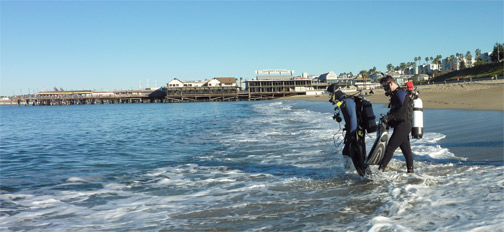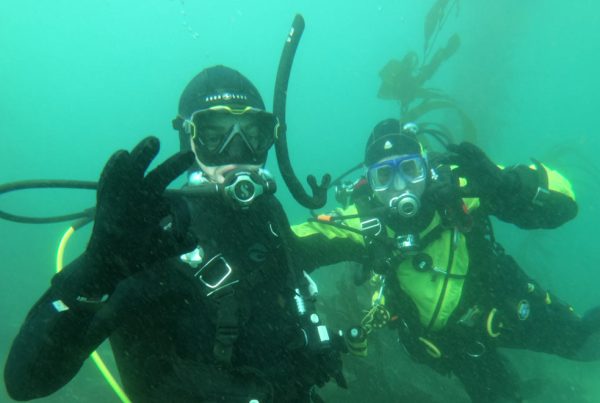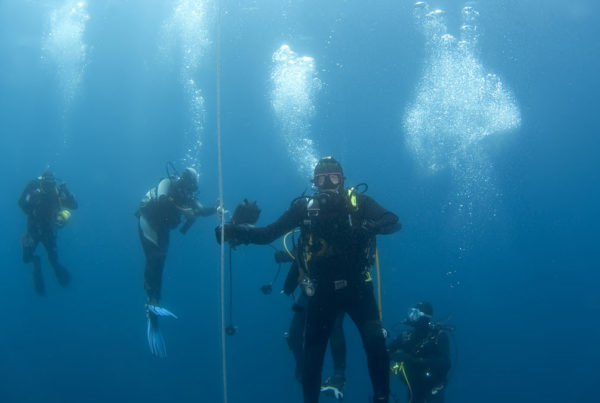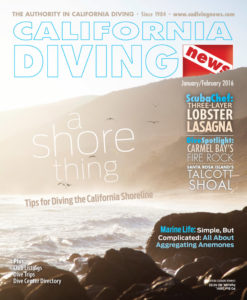 I have had some of my most incredible diving experiences on beach dives. Many frequent beach divers will testify to the same. All three of my gray whale encounters have been while beach diving, same as my dolphin encounters. Other diving fun that I have had only while beach diving includes staring a mola mola in the eye and watching a massive school of squid in a mating frenzy. While perhaps not unique to beach diving I have also caught lobster, dived with sea lions, giant black sea bass, white sea bass, barracuda, angel sharks, and massive bat rays. Beach diving has many wonderful experiences waiting for you.
I have had some of my most incredible diving experiences on beach dives. Many frequent beach divers will testify to the same. All three of my gray whale encounters have been while beach diving, same as my dolphin encounters. Other diving fun that I have had only while beach diving includes staring a mola mola in the eye and watching a massive school of squid in a mating frenzy. While perhaps not unique to beach diving I have also caught lobster, dived with sea lions, giant black sea bass, white sea bass, barracuda, angel sharks, and massive bat rays. Beach diving has many wonderful experiences waiting for you.
Boat diving will never lose its appeal but you’ll find beach diving opening many doors of opportunities. California has some of the best beach diving in the country and it has advantages often not considered.
The Benefits of Beach Diving
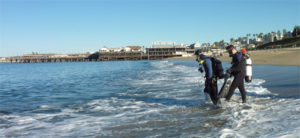 First, it’s relatively inexpensive. You’ll be paying for little more than air fills, some fuel for your automobile, parking fees and perhaps a bite to eat. When I was a teenager and into college this is how I kept diving. Even during the lean years of owning a fledgling business, I was beach diving almost as much as I was boat diving.
First, it’s relatively inexpensive. You’ll be paying for little more than air fills, some fuel for your automobile, parking fees and perhaps a bite to eat. When I was a teenager and into college this is how I kept diving. Even during the lean years of owning a fledgling business, I was beach diving almost as much as I was boat diving.
Second, you’re afforded flexible scheduling. With the exception of the limitations of conditions and buddy availability, you can pretty much pick where and when to dive. Also, sometimes you can’t set aside an entire day to dive. You can usually complete a beach diving excursion in just a half a day, maybe less.
Third, the risk of seasickness — which is a significant challenge for my wife and dive buddy, Kim — is mitigated. Kim has never succumbed to seasickness on a beach dive.
Finally, there’s variety. You literally have miles and miles of California coastline to explore as a shore diver.
Diving from shore has its challenges, but with the proper training, equipment, and knowledge of the dive sites, you’ll find that beach diving is highly rewarding. Some key factors to consider are the dive site location, its natural features, wave action, timing, and techniques appropriate for the site.
Wave Watching
Perhaps the biggest concern of beach divers is dealing with waves and surf. Some knowledge on wave mechanics is helpful.
An ocean wave is created where the energy of the wind and water interact. This wave energy travels across the sea until it collapses on the shore, in a process known as a wave cycle. Waves are classified by height, wavelength and wave period. The highest part of the wave is its crest, while the trough is its lowest point. Wavelength is defined as the horizontal distance between the crest of one wave and the crest of the next — wave top to wave top. The wave period is the time it takes for two successive waves to pass a fixed point.
As ocean surf waves move closer to shore they break forming surf. The nearshore area where wave water reaches the beach is known as the surf zone.
How surf behaves is often dictated by the shape and makeup of the bottom. If the beach slope is steep, the waves are generally more powerful because they build quickly and expend their energy quickly. These are often called plunging breakers. The good news is that beaches with this kind of surf have short surf zones that can be passed through quickly. If a beach slope is gentle then the surf zone is wider but the waves have less power, with breakers that spill rather than plunge.
When you see divers at a beach dive site staring out to see, they’re not daydreaming. Instead, they’re studying the waves in order to plan their shore entry. If you watch a beach for about 15 minutes you will see that there will be a series of larger waves (usually 3 to 6) followed by a period of smaller waves, or perhaps no waves. The larger waves are known as a set. The time between sets is usually around 4 to 8 minutes. This is important to know, as you will want to time your water entry and exits according to these intervals. Time your entry and exit between sets and between waves for maximum ease.
If waves are hitting the beach at an angle, the net flow of the energy along the beach will be influenced by the direction of the waves. This is known as a longshore current. If you are heading for a specific location offshore you need to take this into consideration as you swim out through this current to the destination. The same goes for the return trip. For the most part longshore current is limited to the surf zone and a short distance outward.
Rip currents (sometimes mistakenly referred to as “rip tides”) are isolated outward flows of water offshore. As moderate to heavy surf pushes up on to the beach the water seeks the path of least resistance to head back out to sea. Troughs in the bottom give the water this flow area resulting in the rip current outward. On a sand beach, rips can usually be spotted from the surface by a plume of discolored, even frothy water heading out to sea on a sand beach. On a rocky beach they are a bit harder to spot, but if conditions are relatively calm you can often see a line of small choppy waves crossing the surf zone; this indicates the presence of a rip current.
In some instances, “riding the rip” out to the dive site can be an advantage, but if you get caught in a rip current do not try to swim against it, directly to shore. Instead, swim perpendicular to it to until you are out of the current before turning towards shore.
Geography Plays a Role, Too
Most of the California coastline down to Point Conception faces west, and the prevailing weather comes in from the northwest. From Point Conception north, beach diving becomes challenging with the exception of the Monterey area with its multiple coastal twists and turns and protected coves and bays.
The north coast also has coves that can sometimes be counted on for protected surf entries and exits but the north coast requires a fair amount of skill and local knowledge best acquired from local dive shops and experienced divers.
At Point Conception the coastline makes a radical turn to the east then curves back around toward San Diego. This is known as the California Bight. Beaches within the Bight are more protected. The offshore Channel Islands also provide a limited amount of swell protection to the coast. Of course it depends on specific location but for the most part southern California beach divers have the luxury of manageable surf 250 days a year or more.
On a local level you may have general areas that have a number of beaches and coves that face different directions. While some face west, some south, and there are even beaches that face north. What this means for divers is that we have choices. In many areas it is possible to find a calm beach somewhere nearby. The Palos Verdes Peninsula, for example, has several alternatives.
If you are scheduling a beach dive with your buddy, try to be flexible about location. If a heavy swell is coming in from the south, head for a protected west-facing beach. A buddy and I had hoped one particular Saturday to dive a south-facing beach along the Palos Verdes Peninsula. Checking out the surf reports online (more on that later) we discovered that a south swell was rolling in and there was a nearby more protected northwest cove. We adjusted our plan. It worked out well and we had an enjoyable dive with a relatively easy water entry and exit.
Data Mining for Diving
When it comes to setting an actual date for a beach dive, be flexible. Much of the time in southern California and often in the Monterey we have the odds in our favor of good conditions in a general area.
Offshore winds, in southern California often referred to as Santa Ana winds, push the cloudy nearshore waters offshore, promoting the upwelling of clearer waters. These offshore winds also tend to lay down the surf. After a day or two of offshore winds, providing the surf is low, beach diving will be outstanding. Drop the golf clubs, abandon the lawn mowers and head for the beach!
Many resources are available for gathering intel on potential dive sites. First is your local dive center. They can help you find the best dive sites according to prevailing conditions.
Next, visit websites that offer weather and surf forecasting information. The Coastal Data Information Program’s (CDIP) Integrative Oceanography Division provides useful data on wave height, direction, intensity, and more. Visit cdip.ucsd.edu.
Another useful site is Surf-Forecast.com, which provides wave and wind maps, surf and wind alerts and other useful data.
You’ll want to gather information on tides, too, so you can plan your dive around a favorable tide, which is usually during a high tide. A quick Google search of “California tide tracker” revealed hundreds of thousands of related sites to choose from. Try wavecast.com.
Finally, if you’re planning a shore dive within three days after a major storm, you may want to reconsider. Not only do storms make the water cloudy, but in some instances a health advisory may be in effect due to high levels of contaminants in the water.
Getting Dive-Ready
In packing for a beach dive be extra careful to ensure you have everything and that it is all working well, including a full tank. While dive boats will sometimes have odds and ends you might need in a pinch, and a compressor for fills, at the beach you are on your own. Be sure to pack a spare parts kit.
Consider gathering your gear in a large plastic tub rather than your gear bag. This will keep the sand and saltwater out of your vehicle. Speaking of keeping things clean, a large jug of warm water is helpful. Most beach dive sites do not have showers. This will allow you to rinse yourself and sensitive items of gear like regulators after a dive. In addition, a mat or tarp will help keep you, your gear and vehicle cleaner. Finally, you might want to bring a small dry box that you can stow away securely for your keys. Another alternative is a small lockbox that inserts into a trailer hitch. See hitchsafe.com for more information.
On arrival at the dive site take more than just a couple of minutes to assess the conditions. Note the wave size, time between waves, how many waves in a set, and time between sets. You’ll be using these time calculations for your surf entry and exit. Take the time also to review your dive plan with your buddy including contingency plans such as an alternate exit point.
Note also the largest wave. Should you feel you couldn’t handle it, skip the dive or head to another possibly safer location. Remember, you cannot get hurt on a dive you don’t do.
Training for Beach Diving
The best entry is always the safest entry. And the way to stay safe is to learn how to beach dive through proper training rather than attending “the school of hard knocks.”
Before you start out on your own, consider enrolling in a beach diving specialty course. At minimum, sign up for a guided dive offered by your local dive center, or buddy up with knowledgeable shore divers who can assist you by helping you plan and safely execute your first several shore dives.
The San Diego Council of Divers offers workshops known as the “3Rs” (Reef, Rocks, and Rips). Meetings are at various specific dive sites where participants not only learn beach diving techniques but are also presented with information about the local dive sites. This free program is especially valuable to divers, but is also open to snorkelers and swimmers. Go to sddivers.com/3rs.html for more information.
Incredible dive experiences await you right off the beach! Millions head for the beach every year and gaze at the sea. Almost as many stare wondering what lies below. We divers have the privilege of exploring those underwater realms that are often just a few minutes drive and a small number of fin flips out and downward.
Dale’s Surf Entry Soapbox
I’ve made my share of shore dives, and over the years I’ve adapted my personal way of going about it.
Other folks might have differing opinions, but here’s my little sermon on surf entries:
• Enter the water with your mask on your face and your regulator in your mouth. Always.
• If you have to take a wave, use one hand to keep your mask and regulator in place.
• Entering with your fins on is more of a personal choice depending on conditions. If you choose to enter with your fins off make sure the fin straps are firmly looped over your wrist. If the surf is up, or the entry is tougher, go in with your fins on. Remember, without your fins on your feet you have little, if any propulsion.
• Move through the surf with a side shuffle, not a backward shuffle. Don’t turn your back on the surf. With a side shuffle you are more prepared to take a wave by thrusting your shoulder into it with your feet firmly planted. Remember to hold that mask and regulator in place! It is better, however, to go under the breaking wave. The force of the wave is primarily spilling over the top. Below the wave the water is flowing backward out to sea from a previous wave. Take advantage of this water flow. If you go down, stay down and use the flow of the water to take you out.
• Get through the surf zone as quickly as possible.
• Do not hold hands with your buddy. When holding hands if one diver goes down, so does the other.
• When entering and exiting the water, time the sets. Get through the surf zone quickly, leave your mask on and regulator in your mouth and consider exiting with your fins on depending on the conditions.

